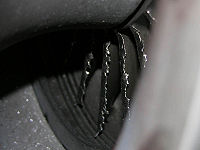
Photo from wikipedia
When a tribological system is operated for the first time, the first hours of operation are of the utmost importance as the surfaces of the contacting elements mate to each… Click to show full abstract
When a tribological system is operated for the first time, the first hours of operation are of the utmost importance as the surfaces of the contacting elements mate to each other, involving significant wear processes until the surfaces reach stable topological characteristics. This initial phase in a combustion engine is known as running-in and is of critical importance in the study of friction and wear phenomena. Despite this, there is little information in the literature dedicated to running-in and, therefore, data improving its understanding is greatly anticipated. In this work, a novel wear debris detection system measuring in real time was employed to investigate the running-in of an inline 4-cylinder gasoline engine; it consists primarily of an optical sensor with the capability of detecting very small particles from 4 μm. For the tests, the engine was mounted on a test bench and operated under stationary working conditions. The results of the wear debris measurements showed interesting insights into the engine running-in process; although in general, the results followed the expected trend, they also showed an unexpected behavior: it was expected to obtain the highest amounts of wear debris at the beginning of the running-in, but instead the number of debris stagnated and only started to increase after about 20 h to then decrease again. The best operating conditions to run-in the engine were identified at the middle of the running-in period, without the presence of large wear debris that could lead to severe wear. Finally, it was found that the engine running-in was not finished until at least 75 h of operation, although commonly, a running-in time of 10 h is used in the industry.
Journal Title: Lubricants
Year Published: 2023
Link to full text (if available)
Share on Social Media: Sign Up to like & get
recommendations!